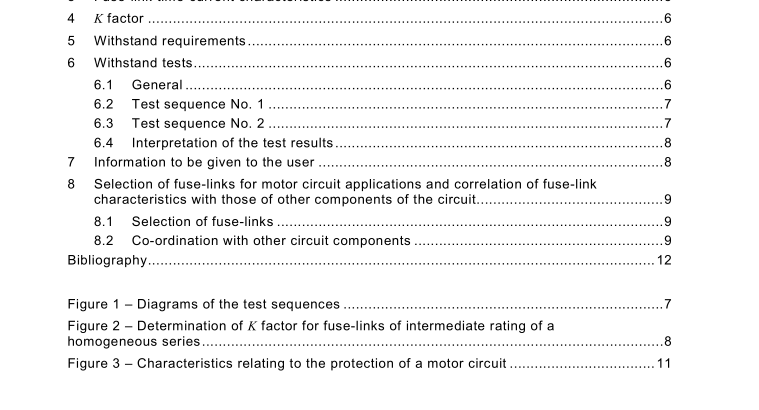IEC 60644:2009 pdf download – Specification for high-voltage fuse-links for motor circuit applications
The term ( ) 25 , 0 100 n I is introduced to take account of the fact that the pre-arcing time-current characteristics for a range of fuse-links diverge as they approach the short-time region.
4 K factor
Factor which defines an overload characteristic to which the fuse-link may be repeatedly subjected under specified motor starting conditions, and other specified motor-operating overloads, without deterioration. For the purpose of this specification, the value of K is chosen at 1 0 s. Unless otherwise stated by the fuse-link manufacturer, it is valid from 5 s to 60 s, for a frequency of starts up to six per hour and for not more than two consecutive starts. For conditions different from those specified above, for example where service conditions involve inching, plugging or more frequent starts, the manufacturer should be consulted. The overload characteristic is obtained by multiplying the current on the pre-arcing characteristic by K (less than unity).
5 Withstand requirements
The performance of a fuse-link for motor circuit applications is in general determined by the following criteria:
– to withstand without deterioration starting pulses in rapid succession due for example to abnormal conditions, such as those occurring during commissioning of the equipment;
– to withstand without deterioration a large number of motor starts in normal service conditions. This standard therefore specifies two sequences of tests representative of these conditions: 1 00 cycles corresponding to abnormal service conditions; 2 000 cycles corresponding to normal service conditions. It is expected that a fuse-link which passes these tests will have a good behaviour during a satisfactory life duration.
6 Withstand tests
6.1 General The withstand tests are type tests. Both test sequences shall be carried out on the same fuse- link. The fuse-link shall be tested under the same test conditions as in 6.5.1 .2 of IEC 60282-1 . The values of test currents shall be 10 f I K for pulses simulating the motor starting pulses and 6 10 f I K for periods simulating the normal motor running, 10 f I being the pre-arcing current at 1 0 s. The tolerance on both values shall be 10 0 + %. The duration of individual pulses shall be 1 0 s. The tolerance on the 1 0 s periods, both pulses and off periods, shall be ±0,5 s. Tests shall be made at any convenient voltage and at a frequency from 48 Hz to 62 Hz.
6.4 Interpretation of the test results After each test sequence is completed, the fuse-link shall be allowed to cool. After cooling, there shall have been no significant change in its characteristics. A check need not be made until after completion of both test sequences. Measurements to show that there is no significant difference in the values of resistance of the fuse-links before and after test give an indication of conformity with this requirement. In case of doubt, a further method is to subject the fuse-link after cooling after test to the current 10 f I K sustained for a sufficient time to cause the fuse-element to melt. The pre-arcing time shall lie within the tolerances of the pre- arcing time-current characteristic given by the manufacturer. If fuse-links form part of a homogeneous series as defined in items d), e) and f) of 6.6.4.1 of IEC 60282-1 , the maximum and minimum current ratings only need be tested. If the same value of K is assigned to both maximum and minimum current ratings, then that value may also be deemed to apply to all intermediate current ratings within the homogeneous series. If different values of K are assigned to the maximum and minimum current ratings, then the K factors for intermediate ratings may be determined by linear interpolation; see Figure 2. If a manufacturer assigns a higher value of K for an intermediate rating than that resulting from interpolation, this assigned value shall be proved by tests to the requirements of Clause 6.
